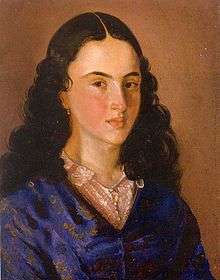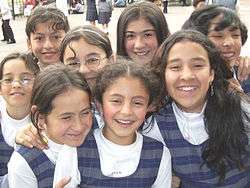Women in Colombia
As established in the Colombian Constitution of 1991, women in Colombia have the right to bodily integrity and autonomy; to vote (see also: Elections in Colombia); to hold public office; to work; to fair wages or equal pay; to own property; to receive an education; to serve in the military in certain duties, but are excluded from combat arms units; to enter into legal contracts; and to have marital, parental and religious rights. Women's rights in Colombia have been gradually developing since the early 20th Century.[5]
 Policarpa Salavarrieta, heroine of the Colombian Independence Movement. Portrait by Jose Maria Espinosa, 1855 | |
| Gender Inequality Index[1] | |
|---|---|
| Value | 0.460 (2013) |
| Rank | 92nd out of 152 |
| Maternal mortality (per 100,000) | 92 (2010) |
| Women in parliament | 20% (2014)[2] |
| Females over 25 with secondary education | 56.9% (2012) |
| Women in labour force | 60% (2014)[3] |
| Global Gender Gap Index[4] | |
| Value | 0.729 (2018) |
| Rank | 40th out of 149 |
| Rights |
|---|
 |
| Theoretical distinctions |
| Human rights |
| Rights by beneficiary |
| Other groups of rights |
History
Background
Women in Colombia have been very unimportant in military aspects, serving mainly as supporters or spies such as in the case of Policarpa Salavarrieta who played a key role in the independence of Colombia from the Spanish empire. Some indigenous groups such as the Wayuu hold a matriarchal society in which a woman's role is central and the most important for their society. Women belonging to indigenous groups were highly targeted by the Spanish colonizers during the colonial era. Many indigenous women were subject to slavery, rape and the loss of their cultural identity.[6]
Throughout the colonial era, the 19th century and the establishment of the republican era, Colombian women were relegated to be housewives in a male dominated society. Education for women was limited to the wealthy and they were only allowed to study until middle school in monastery under Roman Catholic education. On December 10, 1934 the Congress of Colombia presented a law to give women the right to study. The law generated controversy, as did any issue related to women's rights at the time.
Educational rights

| Rights in Colombia |
Animal rights |
| Children's rights |
| Civil rights |
| Collective rights |
| Fathers' rights |
| LGBT Rights |
| Group rights |
| Human rights |
| Individual rights |
| Legal rights |
| Men's rights |
| Natural rights |
| Reproductive rights |
| Social rights |
| Women's rights |
| Workers' rights |
| Displacement |
| Youth rights
|
Before 1933 women in Colombia were only allowed schooling until middle school level education. Liberal congressman Jorge Eliécer Gaitán defended the decree Number 1972 of 1933 to allow women to receive higher education schooling, while the conservative Germán Arciniegas opposed it. The decree passed and was signed by the Liberal government of Alfonso López Pumarejo. The state-owned National University of Colombia was the first higher education institution to allow female students. Gerda Westendorp was admitted on February 1, 1935, to study medicine. Gabriela Peláez, who was admitted as a student in 1936 and graduated as a lawyer, became the first female to ever graduate from a university in Colombia. In 1936, María Carulla founded the first school of social works under the support of the Our Lady of the Rosary University. After this, women began to be seen by many as equal to men for their academic achievements, creativity, and discipline. At the same time, citizens began to support the idea of citizenship for women following the example of other countries. The constant political violence, social issues, and economic problems were among the main subjects of study for women, mainly in the areas of family violence and couple relationships, and also in children abuse.
Legal contracts rights
A group of women led by Georgina Fletcher met with then-president of Colombia Enrique Olaya Herrera with the intention of asking him to support the transformation of the Colombian legislation regarding women's rights to administer properties. The law was named ley sobre Régimen de Capitulaciones Matrimoniales ("Law about marriage capitulations regime") which was later proposed in congress in December 1930 by Ofelia Uribe as a constitutional reform. The law's main objective was to allow women to administer their properties and not their husbands, male relatives or tutors, as had been the case. The move generated a scandal in congress. It did not pass, and later generated persecutions and plotting against the group of women. As leader of the group, Georgina Fletcher was persecuted and isolated. The Régimen de Capitulaciones Matrimoniales was once again presented in congress in 1932 and approved into Law 28 of 1932.
Suffrage rights
Women's right to suffrage was granted by Colombian dictator Gustavo Rojas Pinilla in 1954, but had its origins in the 1930s with the struggle of women to acquire full citizenship. In 1957 women first voted in Colombia on a plebiscite.
Family life
Cohabitation is very common in this country, and the majority of children are born outside of marriage. In the 2000s, 55,8% of births were to cohabiting mothers, 22,9% to married mothers, and 21,3% to single mothers (not living with a partner).[7] Family life has changed dramatically during the last decades: in the 1970s, 68,8% of births were inside marriage;[8] and divorce was legalized only in 1991.[9]
Issues
Domestic violence
In the 1990s, Colombia enacted Ley 294 de 1996, in order to fight domestic violence.[10] In 2008, Ley 1257 de 2008, a comprehensive law against violence against women was encted.[11] Marital rape was criminalized in 1996.[12] Article 42 of the Constitution of Colombia provides that “Family relations are based on the equality of rights and duties of the couple and on the mutual respect of all its members. Any form of violence in the family is considered destructive of its harmony and unity, and will be sanctioned according to law.”[13]
Abortion
Abortion in Colombia is severely restricted, although the laws were loosened in 2006 and 2009. The vast majority of abortions are performed illegally, many in unsafe conditions.[14]
The armed conflict
The armed conflict in the country has had a very negative effect on women, especially by exposing them to gender-based violence.[15] It is reported that one in five of women who were displaced due to the conflict were raped.[16]
References
- "Table 4: Gender Inequality Index". United Nations Development Programme. Retrieved 7 November 2014.
- http://data.worldbank.org/indicator/SG.GEN.PARL.ZS
- http://data.worldbank.org/indicator/SL.TLF.ACTI.FE.ZS/countries
- "The Global Gender Gap Report 2018" (PDF). World Economic Forum. pp. 10–11.
- (in Spanish) University of Vigo; political rights and citizenship of Colombian women
- (in Spanish) Colombialink.com: First woman to enter a university
- "Archived copy" (PDF). Archived from the original (PDF) on 2015-04-02. Retrieved 2015-06-14.CS1 maint: archived copy as title (link)
- "Archived copy" (PDF). Archived from the original (PDF) on 2015-04-02. Retrieved 2015-06-14.CS1 maint: archived copy as title (link)
- https://www.bbc.com/news/world-latin-america-19390164
- http://www.hsph.harvard.edu/population/domesticviolence/colombia.dv.96.htm
- http://www.sdmujer.gov.co/images/pdf/ley1257.pdf
- http://www.omct.org/files/2004/07/2409/eng_2003_04_colombia.pdf
- http://www.omct.org/files/2004/07/2409/eng_2003_04_colombia.pdf
- http://www.guttmacher.org/pubs/Unintended-Pregnancy-Colombia.pdf
- http://www.cidh.oas.org/women/Colombia06eng/part2co.htm
- http://www.omct.org/files/2004/07/2409/eng_2003_04_colombia.pdf
Further reading
- (in Spanish)BANCO DE LA REPÚBLICA – BIBLIOTECA LUIS ANGEL ARANGO – BIBLIOTECA VIRTUAL. Débora Arango, Reseña de Exposición Restrospectiva. Santafé de Bogotá, Abril-Septiembre, 1996. (Bank of the Republic - Luis Angel Arango Library - virtual library. Debora Arango, Restrospective exposition. Bogota April–September 1996)
- (in Spanish)DE KARPF, Ana. “Balance de 40 años del voto femenino”. En: Unión de Ciudadanas de Colombia. Memorias, 5º Congreso Nacional. Cali, octubre, 1997.
- (in Spanish)JIMENO, Gladys. Las semillas dan sus frutos. En Memoria de María Consuelo Niño, Bogotá, 3 de julio de 1986. Fotocopia.
- (in Spanish)LUNA, Lola. Los movimientos de mujeres en América Latina y la renovación de la Historia Política. Universidad del Valle – Centro de Estudios de Género Mujer y Sociedad. Editorial La Manzana de la Discordia, Santiago de Cali.
- (in Spanish)MEDINA, Medófilo. “Mercedes Abadía – el movimiento de las mujeres colombianas por el derecho al voto en los años cuarenta”. En: En Otras Palabras No.7. Mujeres que escribieron el siglo XX. Construcciones del feminismo en Colombia. Santafé de Bogotá D.C. Colombia, Enero-Junio de 2000.
- (in Spanish)MUSEO DE ARTE MODERNO DE MEDELLÍN. Débora Arango, 1937-1984. Exposición Retrospectiva. Catálogo Medellín. 1984.
- (in Spanish)PELÁEZ MEJÍA, Margarita María y Luz Stella Rodas Rojas. La Política de Género en el Estado Colombiano: un camino de conquistas sociales. Editorial Universidad de Antioquia. Medellín, 2002.
- (in Spanish)Periódico Una voz insurgente, 1944.
- (in Spanish)SCOTT, Joan. “El problema de la Invisibilidad”. En: RAMOS ESCANDÓN, Carmen (Comp.). Género e historia, Instituto MORA-UAM, México, 1992.
- (in Spanish)TORRES GIRALDO, Ignacio. María Cano: Mujer Rebelde. Editorial La Rosca, Bogotá, 1972.
- (in Spanish)URIBE DE ACOSTA, Ofelia. Una Voz Insurgente, Ediciones Guadalupe, Bogotá, 1963.
- (in Spanish)VELASQUEZ TORO, Magdala, Catalina Reyes y Pablo Rodríguez. “Proceso histórico y derechos de las mujeres, año 50 y 60. Las mujeres en la Historia de Colombia. Tomo I, Editorial Norma, 1995.
- VELÁSQUEZ, Magdala y otros. 40 años del voto de la mujer en Colombia. Feriva, Cali, 1997.
